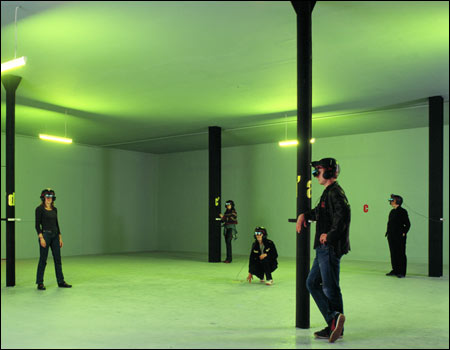Put aside everything you think you know about art for the sake of experiencing the sensual extravaganza of “Sensorium,” the ambitious, technically astute, and at times mesmerizing List Center exhibit that addresses the intersection of technology and physical sensation. Six international artists ranging in age from 34 to 65 and working in media ranging from sweat-scented walls to headgear that allows you to see what others are seeing embrace technology with varying degrees of playfulness, involvement, and wit. At their best, we’re made to see ourselves if not differently then at least with our awareness pricked, though touch (which corresponds with the largest sense organ of the human body, skin) and taste prove to be the two senses least engaged.

UBIQ, A MENTAL ODYSSEY: Mathieu Briand’s installation might not exactly challenge the foundation of Western thought, but it’s cool. |
The show’s highlight might be French artist Mathieu Briand’s Ubiq, a Mental Odyssey, where you start by entering a room inspired by 2001: A Space Odyssey. One super-bright white wall (unfortunately off to the right so as to go almost unnoticed) encompasses a large video screen of the earth in orbit as seen from outer space. Directly in front of you stand some similarly white, space-age benches upholstered in blood-red plastic; behind them is a set of tall columns through which you must pass to enter the rest of the gallery. Each column has a shelf on which a strange helmet rests, and with the aid of an attendant, you’re invited to strap yourself into the cumbersome headgear, which is equipped with lenses, earphones, and a hand-held device with a prominent red button. Push the button and the fun begins — suddenly you’re no longer seeing through the lenses balanced on your nose. Instead, you’re seeing what somebody else wearing another helmet is looking at. The high-tech hall of mirrors gets especially interesting when the channel changes and you see yourself — that is, the self another participant is seeing when you happen to tap into his or her apparatus.
Although the technology isn’t uniformly up to snuff (my first helmet didn’t work), the effect is captivating, even delightful, as your perspective switches from deliberately to inadvertently changed. Does that mean, as curator Yuko Hasegawa claims in her catalogue essay, that Briand’s inventiveness challenges the notion of subject and object and by extension the foundation of Western thought? I doubt it. Looking at the world from another’s point of view has been the domain of language for at least as long as there have been stories and poems. What’s new here, and pleasurable, is the medium, not the message.
When somebody says a work of art stinks, it’s not always a metaphor. The second installation in “Sensorium” is the olfactory contribution by Norwegian artist Sissel Tolaas, who has through a chemical engineering process undoubtedly as complex as Ubiq’s devised a way of releasing odors by having viewers rub their hands against the wall. The walls devoted to FEAR of smell — the smell of FEAR are divided into nine (15 in its original incarnation) numbered partitions, each on the order of eight by 30 feet; the numbers correspond with nine fragrance bottles lined up on a nearby shelf that contain in concentrated form the scents released in this interactive exhibit. A warning sign (this is one of those rare instances when reading the wall text is a matter of personal health) cautions against releasing the distilled liquids, and for good reason. Tolaas hasn’t come up with just any aroma to fill the air. Instead, she’s replicated the scents of nine people in states of high anxiety. We learn that she “cotton-swabbed the body smell of 15 men . . . each of whom was profoundly afraid of something or someone.”